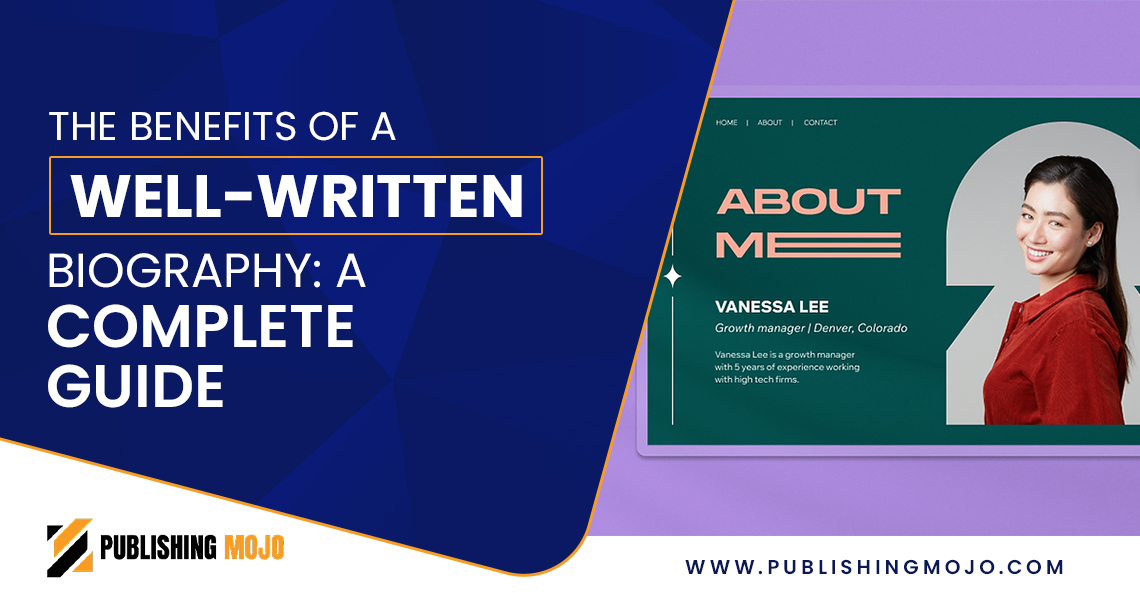If you have a success
story that you think might help others or are keen on sharing your life's
journey, you must write a biography!
Writing a biography
book helps you create an account that shares your life’s profound encounters!
A biography is a
profile of a person's life, with essential details about key events.
A biography structure
is based on detailed research and is mostly nonfiction. Besides, it can include
anecdotes, quotes, and photographs.
When you wonder how
to write a biography book, you must know that it is an essential skill. Besides,
to follow the right structure of a biography, you do not want to overstate it,
and you cannot appear too modest.
Biographies inspire people and shape their lives in a meaningful way. They carry great value and provide the reader with insight into someone’s life. However, you must follow the proper tips for writing a biography to document and share your encounters.
In this article!
In this article, let
us discuss the benefits of writing a biography. Let us also explore how you can
use the proper tips for writing a biography and effectively sharing your
encounters.
Understanding the Structure of a Biography!
A superb biography structure helps capture the reader’s interest and pulls them in.
The structure of a biography follows an order, starting with the subject's birth and going until their death. The benefit of this approach is that it is simple to follow.
Below are some useful tips for writing a biography:
Introduction!
You must start with the subject's childhood and then move into the later stages of their lives. If the subject is still alive, include details on their later life.
Main body!
When you write a biography, create statements or phrases with your main idea for the biography. You must also add details of the subject's life and major events.
Conclusion!
When writing a biography book, you can add what the subject is doing now or how they are remembered.
In conclusion, you must explain the impact of the subject’s life on the world. Besides, it must tell readers about the subject's notable actions and lessons learned from them.
You must follow the right structure of a biography. It helps outline thoughts and makes the work simpler to understand.
A decent structure helps readers follow the story and better understand the subject's life.
Examples of formats!
The difference between an autobiography and a third-party biography is the writing perspective.
Autobiography!
This form of biography structure is written by the subject of the story and offers a subjective account of their life.
These are written later in the subject's life and provide an account of their thoughts and emotions.
Third-party biography!
This form is penned by someone other than the subject of the story. Besides, it is written using research and sources to provide a balanced depiction of the subject's life.
Tips for Writing a Biography!
One of the best tips for writing a biography is picking the right person or story. The person you choose to write a biography on must have an appealing life story that speaks to everyone. Besides, their narrative should touch upon notable themes, making it more appealing. As a result, it can deeply connect with readers.
Thorough research is vital for writing a biography book because it ensures correctness and provides a detailed understanding of the subject's life. Besides, it allows you to present a balanced perspective. In addition, it creates a credible and engaging narrative with vital details, context, and key events from the person's life instead of just a superficial overview.
A biography must present provable facts about a person's life, and to do so, it requires seeking trusted sources to avoid false data.
When you gather facts to write a biography, you research the diverse contexts of the subject's life. As a result, you can explain their decisions and challenges.
A decent biography structure presents all aspects of a person's life. However, you must use research and interviews to achieve the right blend.
Detailed research allows you to find details that enrich the biography structure and make it more engaging.
Balancing facts with narrative!
There are many tips for writing a biography. However, a vital one is that you must ensure that the outcome reads like a story. You must also use narrative techniques to create an engaging story.
Choosing the right tone for your writing is vital. It helps guide the author's attitude towards the subject, which is conveyed through their use of language.
Tone is vital because it impacts how the reader perceives the subject, as well as the facts and examples shared.
A biography must present an unbiased picture of a person's life. Hence, one of the most vital tips for writing a biography is to write eagerly and engage with research.
Key Elements of Writing a Biography Book!
When you write a biography, you must use a beginning that informs the reader about what they will learn when they read. Thus, use quotes that reveal the essence of the subject. You can also add appealing anecdotes about the topic when writing a biography book. This will help enthrall readers from the first sentence.
Characters!
Working on the characters involves their persona, traits, and personal background. You must consider their traits, emotions, strengths and weaknesses, and general attitude.
You must also explore their background and their defining moments and milestones. Besides, focus on how they evolved and what pushed them to keep going!
Focusing on the characters is vital because it helps readers connect with the story and see parts of themselves in the characters. Besides, it drives the plot!
Story arc!
When writing a biography, you need a story arc. It allows readers to follow a clear narrative path through the subject's life, making it more engaging and meaningful. Besides, it shows how the person evolved, faced challenges, and made their mark.
When you write a biography, you must not just present facts. Instead, the best structure of a biography transforms a life story into a great and complete tale with a beginning, middle, and end.
Structure!
The structure of a biography can be chronological or nonlinear. However, your approach must depend on the narrative you want to share!
Chronological!
This structure of a biography presents events in the order they happened, and the story has a beginning, middle, and end.
Non-linear!
This structure of a biography presents events out of chronological order, and the story may jump around in time. This structure can use techniques like flashbacks, flash-forwards, or parallel storylines.
The non-linear approach can challenge readers and create a complex narrative!
The Role of Biography Structure in Telling a Powerful Story!
Biographies often include historical context to help readers understand broader events. However, you need the right structure of a biography to help readers understand the person and their life. If you have multiple topics to include, order them based on their relevance.
The best structure of a biography must have a standard timeline, which is an arrangement of the key events in a person's life. Besides, it uses a common structure and is simple to follow. As a result, it is effective in sharing details of the key events of the person’s life.
The best accounts connect readers and the subject's journey. How? They share insight into their life and help readers understand their encounters. As a result, they enable them to empathize with the subject!
Biographies provide accounts of people's lives. Besides, they help readers grasp how the subject lived their life.
Learning from the subject's life!
Biographies can help readers learn from the subject's life lessons, thinking processes, and work habits. They can also help readers learn how notable people dealt with challenges.
The best accounts help readers understand the struggles of the subject. They can also help readers understand how their lives evolved.
Gaining insight into how others handle crises!
The best accounts help readers gain insight into how successful people handle crises and solve complex problems.
Writing Techniques for Crafting a Compelling Biography!
To write a biography, a narrative flow is ideal. Besides, it guides the story’s flow. As a result, it also guides readers through events and ideas!
The flow!
When writing a biography book, a narrative flow helps present the details of a subject's life and shows how each element leads to the next.
You must use details to grab interest without changing the facts. Besides, draft the story using distinct elements to give a complete picture of the subject's character, conduct, or thinking.
Adding real quotes!
When writing a biography book, using real quotes from the subject can add depth. However, it is vital to ensure you correctly connect the quotes to their source, with context when needed, and cite where you found them. In short, you must use quotes rightly and smartly!
Vivid details!
Vivid language, details, and anecdotes breathe life into your story. Instead of simply listing facts, use descriptive language to recraft scenes and emotions, immersing readers in the subject's world.
When writing a biography book, proper language helps readers paint a picture of the subject’s world. As a result, you can shape the person’s life events into something magical and pleasing for the readers!
Pacing!
You need the right pacing as your story unfolds. The right balance of pace between slow-building moments and fast-paced action is vital to keeping readers engaged without boring them.
Keep readers piqued!
You must use careful detail to keep the reader piqued and moving forward. Mix fast and slow pacing to create rhythm and interest. In addition, avoid giving away all the details at once.
The Benefits of a Well-Written Biography!
Biographies can help readers learn about history.
For context!
Biographies can provide insight into the social, cultural, and political climate of a particular period.
For a unique perspective!
The best accounts can provide a unique outlook on human encounters by sharing details of the lives of people from diverse backgrounds and cultures.
Learning from notable people!
Biographies can help readers learn from the lives of people who played a significant role in their societies.
When you write a biography, you share about diverse cultures and backgrounds with readers. As a result, they develop empathy for diverse backgrounds and cultures.
The best accounts teach readers how successful people dealt with life's challenges. Readers can learn from the life lessons, thinking processes, success stories, and work habits of the people they read about.
Gaining insight into history!
The best accounts can provide insight into conditions that shaped notable people. Besides, they can inspire others by providing valuable lessons and insights from the lives of notable people. As a result, they immortalize notable figures.
Personal growth!
The best accounts help readers learn from others’ situations and apply those lessons to their lives. Besides, they help readers learn how to pursue their goals smartly.
Empathy and compassion!
Biographies can help readers explore diverse outlooks and cultures and foster empathy and compassion.
When you share about people from diverse backgrounds and cultures, you can broaden readers’ knowledge. Besides, you can help them better understand the world and human encounters.
Wrapping it up!
Biography writing involves
an account of a person’s life. It creates a timeline of events and includes the
family history, key events, and successes. Moreover, it consists of the turning
points in a subject’s life that shape their views of life.
Working on a
structured profile
helps you capture the subject’s successes and encounters well. It also helps
you share their life’s highlights and inspire others. As a result, you can provide
the readers with the value they expect!
A well-crafted biography
helps you understand what life was like for notable people and how they handled
and overcame challenges. It also gives you an insight into their lives and adds
to your life’s lessons. In short, it helps you balance between competence and frankness
in your writing!




